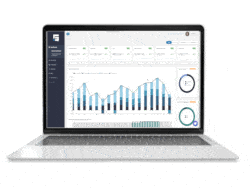Intuit’s QuickBooks Online is widely regarded as one of the most reliable solutions for business accounting services. It is often selected as a solution for small businesses and can work well for commercial real estate. QuickBooks Online is a valuable tool for real estate investors. It helps categorize expenses, reconcile bank accounts, and generate detailed reports on various aspects of real estate. While it isn’t specifically designed for property management, investors can still use it effectively, especially when combined with other software. This blog will explore QuickBooks Online’s accounting features and how it can benefit real estate investors.
Basic QuickBooks Online Setup for Real Estate Investors
Use a Focused Chart of Accounts for Commercial Real Estate
The best way to save time at year-end is to use a focused Chart of Accounts (COA) specifically designed for commercial real estate (CRE). There are many differences between residential and commercial real estate. The largest and most complex difference is having to produce CAM Reconciliations regularly.
A COA that is designed with CRE in mind is the easiest way to gain insight into the profitability of the investment and the most time-saving action that can be taken. The CRE tenants will pay their portion of common area maintenance (CAM), otherwise called Operating Expenses, Additional Rent, or several other terms. When you set up your QuickBooks Online account, clearly distinguish between Reimbursable Expenses and Non-Reimbursable Expenses. This approach saves you time and effort while providing clarity about which expenses you can be reimbursed for.
For more information and a sample Chart of Accounts for Commercial Real Estate, we have several blogs written about the topic, such as Setting up a Chart of Accounts for a Commercial Real Estate Company, which includes a sample COA.
Use Classes for Assets
QuickBooks Online has a feature called Classes. This feature will enable you to run a Profit and Loss Statement (P&L) at the property level, which is especially important if you own multiple properties. If the company/EIN owns more than one asset or property, you can make classes for each of the properties within the same QuickBooks Online account. This allows for separating the income and expenses on the P&L when you select to run the report using the classes option. For more information on how to set up classes in QuickBooks for many different scenarios, please refer to our guide How to Use Classes in Commercial Real Estate for all of the steps needed.
Setting Up Tenants as Customers in QuickBooks
Next, you will set up all of your tenants as customers in your QuickBooks Online account. This will allow you to collect rent and post it to the specific tenant. In the reports section, you will have the ability to run the P&L with “By Customer” selected and get more detailed reporting of each customer and their income on an accrual or cash basis.
Creating Accurate Income Items
Another nuance with CRE is making sure that you are posting your income correctly in QuickBooks. As best practice, create an income item not only for Rent but also for other items such as CAM, Late Fees, and any other items that need invoicing. This will allow investors to easily see on the P&L the difference between the income that is coming in.
You will need to create income items for what you would like the tenant to see on the invoices you create as well. If the lease separates the real estate taxes, insurance, and CAM fees, it may be a good idea to create each of these as separate income items. This allows the tenant to track their charges more easily and also aids in the annual CAM reconciliations.
Recording Loans Correctly
Investors need to rely on the accuracy of the QuickBooks Online account. Accurately creating loans and posting payments in QuickBooks will enhance cash flow visibility for investors in commercial real estate.
When a loan payment is posted, it is important to separate the interest portion from the principal portion. An investor should be able to view the loan account balance in QuickBooks and see the accurate loan balance at any time. The same is true with the interest account.
See our Knowledge Base article and blogs for more information about loans for CREs, such as Why it’s Critical to Track Your Commercial Real Estate Loans.
Make Sure Security Deposits are Posted in QuickBooks
Lastly, depending on your state laws, you must record security deposits in your Balance Sheet accounts. You do not consider a tenant’s security deposit as income unless you withhold it at the end of the lease. Therefore, you should record and present it on the Balance Sheet.
For more information on security deposits, take a look at the following blog: How to Record Security Deposits in QuickBooks.
QuickBooks Online offers greater flexibility for tracking data for real estate investors. This is much more than traditional spreadsheets, which many of our customers transition from. You can learn more about why investors should do away with their Excel spreadsheets in this article, 4 Reasons Investors Need to Say Goodbye to Their Excel Spreadsheets.
Where QuickBooks Online Leaves Off
While QuickBooks Online is a robust accounting platform for small businesses, it lacks the design features needed for commercial property management. Real estate investing is complicated. If you are juggling a number of properties, tenants, different insurance, and operating expense requirements, you need a software solution designed to handle all of the activity. Property management software should offer:
- Consolidated Portfolio Views
- Lease and Rent Roll Management
- CAM Reconciliation
- A Tenant Portal
- ACH Transfers
- Certificate of Insurance (COI) Tracking
- Work-Orders
- Investor Portals and Reports
- File/Document Management
- Loan Management
- Real-time Reporting
Working with multiple software platforms allows real estate investors to customize their operations. Missing features can create bottlenecks in the form of spreadsheets and unshared documents. These roadblocks can seriously hurt your ability to set goals and stay on track. STRATAFOLIO provides a total property management solution that fully integrates with QuickBooks Online. You will have total clarity and control, unlike ever before! Contact us today for a free 1:1 demo to see it in action.






